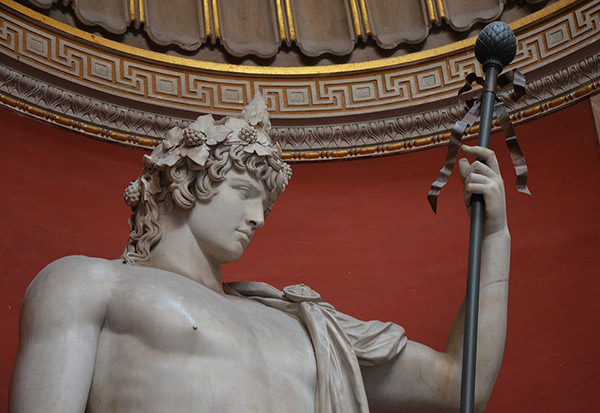Many cultures feature gods, demigods, heroes, and other mythological beings with both male and female attributes, and it is interesting to ask why that might be.
In Hindu mythology, Vishnu’s female avatar, Mohini, seduced Shiva, leading to the birth to the god Shasta (or Ayyappa). Shiva himself is often represented as Ardhanarishvara, an androgynous composite of Shiva and Parvati with a body that is male on the right-hand side and female on the left.
The great warrior of the Mahabharata epic, Arjuna—a kind of Hindu Achilles—spent a year as a woman, during which he took the name of Brihannala, and taught song and dance to the princess Uttara.
Speaking of Achilles, to prevent him from dying at Troy, as had been foretold, his mother the nymph Thetis sent him to live at the court of the king of Skyros disguised as another daughter of the king, under the name of Pyrrha [the red-haired], Issa, or Kerkysera.
Even Thor, the Germanic god of thunder, had no choice but to travel to the land of the giants dressed as a bride to retrieve his hammer, Mjölnir, without which the Asgardian gods would have been overpowered by the giants.
Hapi, the Egyptian god of the annual flooding of the Nile, brought such fertility as to be regarded by some as the father of the gods. He is generally depicted as intersex, with pendulous breasts and a ceremonial false beard.
Hapi might be compared to Tlazolteotl, the Aztec goddess of fertility and sexuality, who was associated with the moon, and, like the moon in Aztec culture, had both male and female characteristics. Tlazolteotl was nothing if not paradoxical: Although she inspired vice, as Tlaelcuani the “Eater of Filth” she was also able—not unlike Jesus—to purify sinners by absorbing their sins.
The Mesopotamian Ishtar, the beautiful goddess of fertility, love, war, and sex, was sometimes represented with a beard to emphasize her more bellicose side. She could change a man into a woman, and the assinnu, kurgarru, and kuku’u who performed her cult had both male and female features. After the hero Gilgamesh rejected her offer of marriage, Ishtar unleashed the Bull of Heaven, ultimately leading to the death of Enkidu, whom Gilgamesh loved more than anyone: “Hear me, great ones of Uruk/ I weep for Enkidu, my friend/ Bitterly mourning like a woman mourning.”
Gilgamesh bears more than a passing resemblance to the Greco-Roman Hercules, who spent a year as a slave to Omphale, Queen of Lydia. Omphale made him wear women’s clothes and sit at the spinning wheel, while she herself wore the skin of the Nemean Lion and brandished his olive-wood club.
To seduce the nymph Callisto, Zeus, the king of the Greek gods, took the form of the goddess Artemis. Zeus took many lovers, but, according to Xenophon, granted immortality to only one, the Trojan prince Ganymede.
Other instances of same-sex (typically male) love in Greek myth include: Apollo and Hyacinthus, Hermes and Krokus, Dionysus and Ampelos, Poseidon and Pelops, Orpheus and Kalais, and Hercules and Abderus, Hylas, and Iolaus. In these pairings, the eromenoi [younger men] usually got killed, with the first three, Hyacinthus, Krokus, and Ampelos, finishing up as plants (hyacinths, crocuses, and the vine).
Also in Greek myth, the prophet Teiresias spent seven years as a woman, even giving birth to children in that time. One day, Zeus and his wife Hera dragged him into an argument about who has more pleasure in sex: woman, as Zeus claimed; or, as Hera claimed, man. Teiresias averred that, “Of ten parts a man enjoys only one.” For this, Hera struck him blind, but Zeus compensated him with the gift of foresight and a lifespan of seven lives.
How might all this gender fluidity be interpreted?
The union of masculine and feminine elements shows them to be complementary, inseparable, or one and the same, while emphasizing divine attributes such as power, creativity/fertility, and boundlessness.
In its completeness, the union of the sexes also represents perfection and self-sufficiency, and, by extension, peace or even ecstasy.
Spiritual schools tend to look favorably upon sexlessness, especially in the priestly caste, since the attraction between man and woman—or indeed between man and man or woman and woman—gives rise to worldly concerns and attachments, such as children and a home, and jealousy and heartbreak, which can detract from spiritual work and the liberation in which it culminates.
In heroes, gender fluidity may mark out the hero as more than a mere mortal. It may also, like the journey into the underworld, symbolize the search for knowledge, and in particular self-knowledge, which is the hallmark of the heroic quest.
Wisdom is perspective, and the pretender has to die to himself to be reborn as a hero, as symbolised by the journey through hell that he often undertakes. The time that the hero spends as a woman, or in the guise of a woman, is, perhaps, another way of making this point.
But there is in all this gender fluidity also an uglier, misogynistic aspect. Especially in Western myths, there is often the suggestion, as with Hercules and Teiresias, that having to spend time as a woman in a humiliating punishment or penance—although, in both these examples, the punishment is meted out by a woman—which may make it better, or worse.
Source : PsychologyToday



